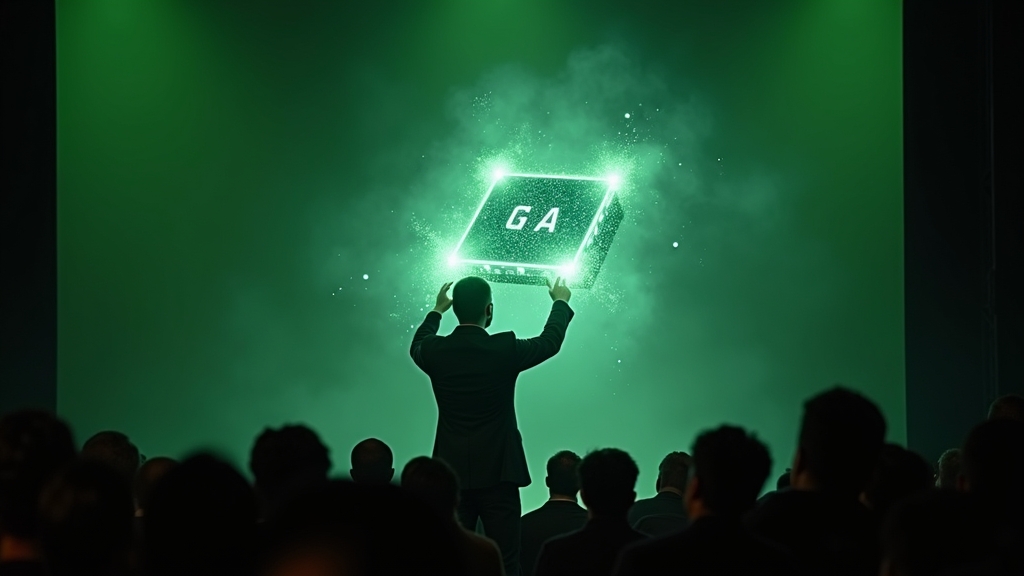“Tech Cult Leader Unveils Shiny New Rectangle That’s Shaped Like the Future, Demands Your Wallet’s Allegiance”
In what tech insiders are now calling “the holy sermon of silicon scripture,” NVIDIA CEO Jensen Huang descended upon CES 2025 with the kind of energy typically reserved for rock stars and doomsday preachers. Standing beneath blinding stage lights and brandishing the company’s new GeForce RTX 50-series GPU like it was Moses’ second tablet, Huang delivered a keynote that reportedly left several attendees weeping, muttering “DLSS is love, DLSS is life.”
The RTX 50-series, touted as the “flagship desktop GPU series that will make time itself obsolete,” comes loaded with features that most of us mortals will never understand or afford. “It’s powered by the new Blackwell architecture, which makes it 200% more capable and 400% more impossible to actually buy,” Huang declared, to thunderous applause from a crowd already Googling “how to sell kidney on eBay.”
“Gamers, creators, and socially-awkward AI researchers rejoice,” Huang proclaimed. “With this chip, you’ll be able to experience lifelike graphics that are indistinguishable from reality—because why go outside when you can load an 18GB foliage texture in 16K? It’s about immersion, people.”
But NVIDIA didn’t stop there. Oh no. Deviating from his tech-guru script, Huang then unveiled what he called “the AI Research Supercomputer of the Gods.” This sci-fi monolith, capable of training Large Language Models faster than you can yell “Skynet,” will pave the way for autonomous cars, AI-driven cities, and perhaps most crucially, the kind of deepfake TikToks no one asked for but will absolutely consume at 3 a.m.
“Imagine a future where robots not only drive your car but roast you for your Spotify playlist choices,” Huang elaborated. “This is the promise of AI. A machine that can tell you that your love of early 2000s emo is both embarrassing *and* algorithmically outdated.”
Critics, however, were quick to question the practicality of NVIDIA’s latest offerings. “Sure, the RTX 50-series sounds neat,” said tech analyst Diana Moore, “but with all these advancements, will it finally fix my improper sandwich textures in Skyrim? I’ve been waiting nine years, Jensen!”
Gamers—those eternal soldiers in the war for marginally higher frame rates—expressed a mixture of awe and despair. “This is hands-down the most powerful GPU of all time,” said Brandon T., a Twitch streamer and noted owner of six RGB setups. “Now the challenge is convincing my wife that $3,000 is a reasonable upgrade from, well, yesterday’s $3,000 purchase.”
Even among Huang’s most devoted followers, concerns have arisen over NVIDIA’s increasingly unhinged naming conventions. “Blackwell architecture? What’s next? The Quantum Space Messiah Series?” asked one CES attendee, clutching their existing GPU like a toddler afraid of losing its security blanket.
Despite these grumbles, NVIDIA remains at the pinnacle of the semiconductor arms race, leaving rivals scrambling to keep up. A spokesperson for AMD was overheard muttering, “Eh, RTX 50? More like RTX Fifty *shmillion*. Whatever, we’ll slap six fans on it and call it innovation.”
As the keynote climaxed with laser lights spelling out words like “FUTURE” and “UNLEASH THE HERTZ,” Huang ascended an LED staircase and dramatically proclaimed, “This is the silicon revolution. Bow down, tech peasants!” Reports of conferencge attendees attempting to baptize themselves with Mountain Dew from free vending machines remain unconfirmed.
In the meantime, the average consumer is left scratching their heads, wondering, “Do I actually *need* all this horsepower to edit Instagram memes of my cat?”
The answer, dear reader, is clearly “yes.”





